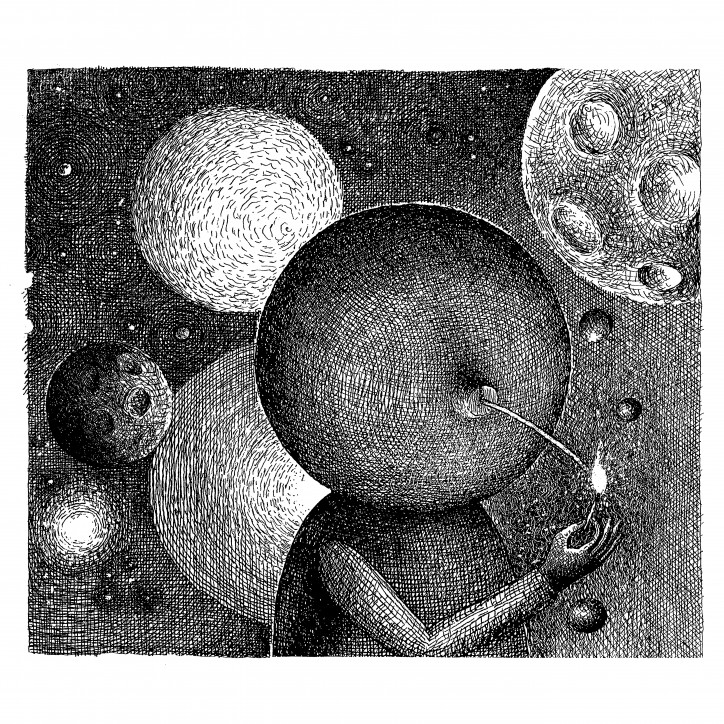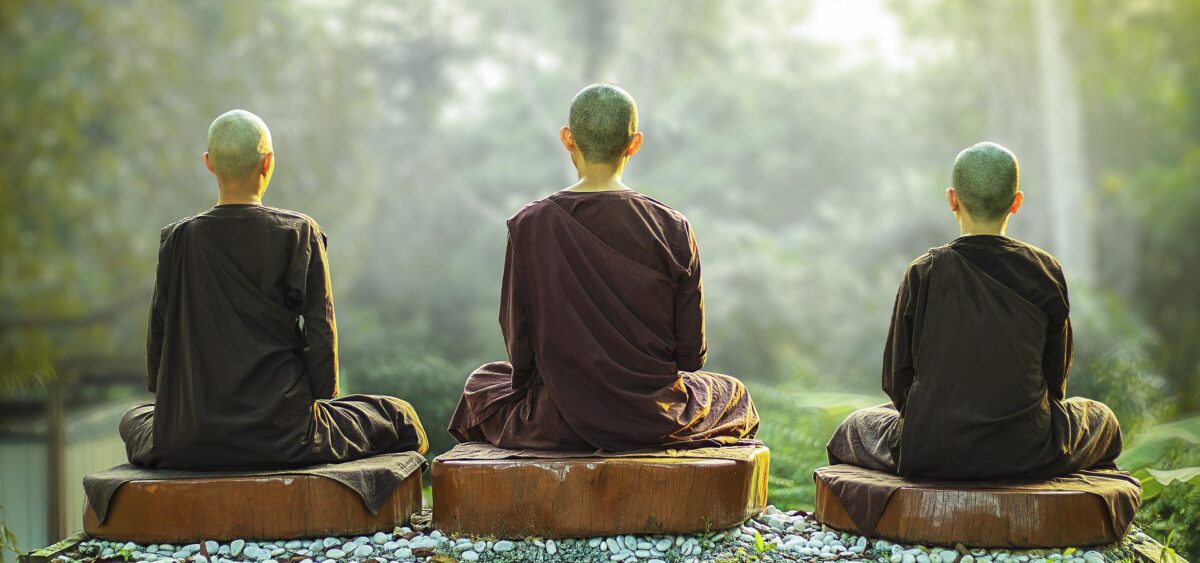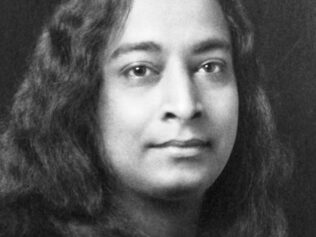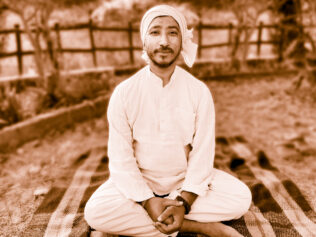
It is hardly possible to imagine the religiosity—or, to put it more broadly, the spirituality—of Hindus, without their spiritual guides and teachers. Gurus do not merely tell people how to live. They also manage various aspects of everyday life.
I get on a tuk-tuk somewhere in the countryside of West Bengal. Swinging in front of me is a sizable keyring with a man’s smiling face in a halo of gray afro hair.
“It’s Shri Sai Baba.” The rickshaw driver named Suraj quickly notices what I’m looking at.
“He was a holy person, man, I’m telling you. The holiest of the holy. I could listen to him for hours. He really made me think. Unfortunately, he passed away.”
“Why is he important to you?”
“Sai Baba taught us that we must do good and take responsibility for our decisions at all times. The Brahma God burdens us at birth with the consequences of our deeds from previous lives, and yet we are not lost! If we make an effort in our present life, we can change our destiny. This is an important truth to me.”
“What else did you learn from him?”
“That God is love, and man is created in God’s image. So it’s clear: we must love! God, other people, the world. It’s a straight path to salvation and it’s what I’ve been sticking to in my life. For years now.”
The Path of Righteousness
I will see many more depictions of Sai Baba in India—in tuk-tuks, shops, hospitals, and public offices. Sathyanarayana Raju, known as Sathya Sai Baba (1926–2011), is regarded as a saint almost everywhere. He is also believed to be the reincarnation of the immensely popular 19th-century guru Shirdi Sai Baba, who allegedly was an avatar—an incarnation—of the god Shiva himself.
The 20th-century Sai Baba preached a return to universal values and codes of conduct shared by the world’s largest religions: Hinduism, Christianity, Buddhism, and Islam. These include love, respect for the truth, the pursuit of peace, and the absolute renunciation of violence against others (called ahimsa in the Indian tradition). The path of righteousness (sanathana dharma), the pursuit of beauty and spiritual harmony, reconciliation with oneself, as well as helping others are the only path to salvation, according to Sai Baba. Keeping with these ideals allows one to experience happiness, gives a sense of belonging in the universe, and coexistence with other sentient beings.
In the teacher’s opinion, the biggest problem of modern people is that they do not strive for perfection, thus missing their purpose in life. This in turn results in sorrow, frustration, and suffering. According to Sai Baba, human desires stem from the unsatisfied need for love and a longing for God. Only a connection with God can give us a sense of fulfillment. Sai Baba’s beliefs are rooted in the philosophy of Hinduism and include many references to the holy scriptures—the ancient Vedas and the Uppanishads (Indian texts concerned with the relationship between the individual soul and the absolute).
The Guru belonged to the Hindu world, but he did not exclude representatives of other religious groups from this community, even agnostics and non-believers. Quite the contrary—he emphasized the equality of all religions, as well as the need to unite them. Sai Baba became popular as a philanthropist and charismatic leader. This ensured his enormous success around the world. The Sathya Sai organization he founded opened more than 1,200 educational centers in 126 countries, and his most faithful followers to this day deeply believe that he possessed supernatural powers. He was said to have the gift of materializing sacred ash (vibhuti) and small objects, such as jewelry pieces and watches.
There are many teachers like Sai Baba in India. Just like him, they preach the need to return to traditional values and the urgency of renewal. What differentiates them from one another are usually minor details and personal charisma.
To Cross the River
The figure of the spiritual master—the teacher—in almost an institution in India. It is believed that true spiritual development is impossible without the support of a guru—they have been admired and respected on the subcontinent for centuries. A guru is someone who “achieved liberation,” is “a transmission belt” from God to the people, a person standing between the sacred and the profane, as well as one who knows how to blur the boundary between these realms in order to support the spiritual development of their followers. The goal in the life of a Hindu is to free themselves from the chain of saṃsāra, the neverending cycle of births and deaths. The guru’s role is extremely important in this context.
In the life of a community, the activity of this exceptional person guarantees the continuity of tradition and numerous values—it is the guru who upholds social relationships and validates cultural identity. They are both mystics and therapists. Besides, the institution of a master-teacher in India influences many fields of life, and its role is much more important than in Western societies. On the subcontinent, the master–disciple relationship is usually much more direct, almost personal. It is no coincidence that many teachers are called baba (“father”)—just like Sathya Sai.
Spiritual leaders are very different from one another in the Hindu tradition. There is the “learned person” called the pandit. Then there is the rishi, who is more of a preacher-sage. The doctrine of Hinduism states that all knowledge comes from the fourteen archetypal rishis who were born in the head of the god Brahma. They were given the honor of learning the Vedic hymns and were charged with passing them on to their followers. The very word “guru” (gu—“darkness”, ru—“to dispel,” “light”) describes one who dispels the darkness and allows others to understand the world. What the guru passes on to their disciples is not so much “knowledge” as “truth,” which is closely related to the spiritual experience of the master. This is well illustrated by the various metaphors that explain the meaning of “guru” in Indian religions. In Jainism, for example, they are someone who “crosses the stream,” leading people from the shore of ignorance to the shore of knowledge. In Tibetan Buddhism, on the other hand, they are assigned the adjective “heavy,” by implication: heavy with knowledge, wiser than wise. Respect for the spiritual guide is described as an ethical requirement in one of the Upanishads, which have the form of a dialogue between teacher and disciple. Even the term itself “upanishad” means “to sit down” at the feet of the master—as is usually the case during teaching.
Modern Indian gurus captivate entire crowds. In the 20th century, Osho (born Rajneesh Chandra Mohan Jain; 1931–1990) also became famous outside of India. The teacher’s life-long mission was to call for a rejection of organized, institutional religion. He also encouraged a highly individualized spiritual practice and the search for a personal mystical experience. Osho was a storyteller: he delivered his teachings in the form of lectures that sparkled with anecdotes and jokes. To this day, he has millions of followers all around the world.
Osho continues to be very popular abroad. Many of his books, such as Pharmacy for the Soul; Love, Freedom, and Aloneness; The Journey of Being Human; Meditation for Busy People; Freedom: The Courage to Be Yourself, andCourage: The Joy of Living Dangerously became international bestsellers. In these books, the guru analyzes human relationships, looks into fears and phobias, and diagnoses the biggest human problems. Most importantly, he tries to find an antidote to the spiritual diseases of modern times. He encourages readers to abandon their routines and take the risk of stepping out of their comfort zone.
Osho looked to Christianity, Buddhism, Jainism, Taoism, Tantra, and Hasidism for inspiration. His teachings were influenced both by the Upanishads and Western psychoanalysis. Moreover, the latter was crucial to all of his teachings: the master believed that meditation is not only a practice, but also—and perhaps above all—a state of mind. In his understanding, meditation allows one to see beyond everyday reflexes, and thus live life authentically. For Osho, enlightenment is a natural state for every human being, but the vast majority of people are unable to perceive it because they are distracted by ceaseless mental activity. Meanwhile, to achieve enlightenment one needs to hone the ability to turn off the mind and position oneself next to reality. The guru believed that apart from meditation, life should be about giving love, conscious action, imaginative creation, and purifying laughter.
Three Days Underground
The power of meditation has been witnessed multiple times by participants of the Kumbh Mela (the Pitcher Festival), the most important of Hindu religious festivals. In 2001, during festival celebrations in Allahabad (now Prayagraj), thanks to a close relationship with her guru, a Japanese yogini named Keiko underwent the ritual of samadhi, which is a unique type of meditation.
The woman spent three days in an earthen pit ten feet deep. A corrugated metal roof was laid over it and covered with cloth and a layer of soil. Keiko began meditating at the bottom of the pit with no water, no food, and severely limited access to oxygen. Her spiritual guide later explained to reporters that his disciple was able to achieve a state “beyond knowing and feeling.” He assured them that during the trial, the woman did absolutely nothing, thought about nothing, and felt nothing. After seventy-two hours, the yogini emerged on a ladder decorated with marigolds, as if nothing had happened, and smiled at the audience.
The Kumbh Mela is also a grand celebration of teachers (or spiritual guides). They are revered anywhere they go. Namaste, shri guru (“Welcome, esteemed master”). I hear these words repeated over and over by pilgrims during the festival in Haridwar. One of the central events of the Kumbh Mela is a parade of saffron-clad gurus who walk through the city. They too, like Keiko, lecture their followers about the philosophy of non-possession and non-attachment.
Contemplation, the need to “look into oneself,” silence—Indian masters often celebrate these ideals. They are the ones who uphold ethical conduct and discipline in the community. They call for modesty, asceticism, worship of God, selfless sacrifice, but they also encourage serenity and participation in religious discussions. They usually lead by example. And sometimes they are even quite radical in their leadership.
A certain event that occurred nearly one hundred years ago is still remembered in India today. On July 10, 1925, guru Meher Baba decided that he would remain silent for the rest of his life. And so he did—for the next forty-four years, until his death in 1969, Merwan Sheriar Irani (his birth name) refused to say a word. He communicated with the world using alphabet boards and later, gestures. He explained that he had not taken a vow of silence, but was simply practicing his own spirituality. In 1954 Meher Baba was hailed as an incarnation of God or a Vedic deity. He is credited as the author of the motto “Don’t worry, be happy,” popularized many years later by the jazz singer Bobby McFerrin.
The Ten Commandments of a Good Life
Yoga is often associated with spiritual development in Indian culture. Mircea Eliade, the eminent Romanian historian of religion (as well as philosopher, diplomat, and writer), claimed that because of yoga, the Indian people had a better chance of understanding the world around them and mastering the nature of reality in an almost magical way. At the same time, it is worth noting that yoga itself is not a religion—even if it is quite often referenced by both Hinduism and other Dharmic religions, such as Jainism and Buddhism. It is a philosophical system that deals with the relationship between body and mind, a discipline of self-improvement, a set of principles to follow in life. It requires unity between body and soul, spiritual harmony, control of the mind, and a healthy body. These ideals may be reached not only through meditative, but also physical exercises (including asceticism), and by following certain ethical principles—preferably under the guidance of a guru. The ultimate goal is to overcome the law of karma and saṃsāra.
Yoga is mentioned as early as 1500–500 BCE in the Vedas, ancient books that recount the assimilation of the Indo-Iranian peoples in present-day Punjab and later, in all of India. It is also the central topic of the treatise Bhagavadgita, which dates back to the third century BCE and has the form of a philosophical dialogue between a military commander, Prince Arjuna, and Krishna, the avatar of the god Vishnu, who drives Arjuna’s chariot. In the treatise, which consists of eighteen songs, Krishna sets the prince on a path of spiritual development. He commands him to resist evil, an obligation which stems from the prince’s social position, and explains what it means to live an ethical life. Krishna becomes Arjuna’s spiritual guide.
The 15th-century yogic manual Hathajogapradipika by Svātmārāma, one of the most important hatha yoga writings today, also contains very specific guidelines for ethical living. The included commandments could be briefly summarized as follows: 1) Do no harm to others; 2) Be truthful; 3) Abstain from taking things belonging to another; 4) Be temperate; 5) Learn to suffer and forgive; 6) Be supportive; 7) Be compassionate; 8) Be honest; 9) Be moderate in eating and drinking; 10) Purify yourself.
One of the first to popularize yoga in the West nearly one hundred years ago was Paramahansa Yogananda (born Mukunda Lal Ghosh). He was a guru who created a yoga and meditation technique called Kriya Yoga. He claimed it was mastered by the ancients and then hidden from the people for centuries, and that he simply reminded the world that the technique existed. It allows the mind to control the breath, which, according to the master, should orbit the seven centers of the spine (the chakras).
In his book Autobiography of a Yogi, Yogananda described his spiritual path. An important part of it were numerous meetings with holy men who became his spiritual masters. These guides and various yogic techniques taught him to control his own body and mind, which in time, he claimed, enabled him to perform miracles. “Man is a soul, and has a body. When he properly places his sense of identity, he leaves behind all compulsive patterns. So long as he remains confused in his ordinary state of spiritual amnesia, he will know the subtle fetters of environmental law,” he wrote in his autobiography.
According to Yogananda, the center of life is God. Except that he does not represent any religion, nor does he expect any sacrifices or rituals from us. People are equal regardless of their origins or philosophies of life.
Published in 1946, Autobiography of a Yogi has had a huge impact on the consciousness of all Indians. What’s more, it strongly influenced Western thinkers (as well as politicians, businessmen, and artists). Suffice it to say that Yogananda’s face was featured, among others, on the famous Beatles album, Sgt. Pepper’s Lonely Hearts Club Band. His book has been translated into thirty-four languages and is still widely regarded as one of the most important works on spirituality of the 20th century.

The Hugging Saint
One of the few women who gained great popularity as a guru is Mata Amritanandamayi (Amma), known as the “hugging saint.” An honest, friendly hug is supposed to help her connect with her disciples, but also make the world at least a little better. During one such “hugging session” in India, Amma hugged as many as fifty thousand people, and it took her more than twenty hours. It is estimated that during her entire life, the seventy-year-old had contact with as many as thirty million people around the world in this way. Her story was presented in Jan Kounen’s 2005 film Darshan: The Embrace, which screened at the Cannes Film Festival.
Amma teaches her disciples how to live, and her impressive charity work furthers this mission. The organization she founded, Mata Amritanandamayi Mission Trust (MATH), builds homes for the poorest, supports hospitals, hospices, orphanages, shelters for victims of domestic violence, nursing homes, soup kitchens. In total, more than one hundred thousand centers have already benefited from such assistance. However, MATH does not limit its activities to India. Under its umbrella, schools, Hindu temples (mandirs), and outreach programs have been created in the United States, including “Mother’s Kitchen” and “Vegetarian soup-kitchens,” where volunteers prepare and serve meals to those in need.
Religious Corporations
There used to be special guidelines in India to distinguish a genuine guru from a charlatan. It was said that an authentic one follows the highest ethical standards in life, is talented, consistent, and generous in their actions. It was also well-seen if the guru came from a family with a teaching (master) tradition, but most importantly, it was forbidden for the guru to use their knowledge, religious symbols, and popularity to multiply personal wealth.
It is precisely the last point that does not always go hand in hand with modern attitudes. The guru mentioned in the introduction, Sathya Sai Baba, was not a holy man for everyone. His critics called him a dangerous puppeteer and made very serious accusations of sexual abuse, money laundering, and last but not least, shady relationships with influential politicians, judges, and religious leaders, which led to corruption. But he was neither the first nor the last Indian guru to provoke such reactions.
In recent years, serious accusations were made against the popular Baba Ramdev, who has strived to maintain the public image of a humble and soulful yogi. The teacher, who publicly renounced the material goods of this world, also happens to advertise noodles, toothpaste, and toilet cleaners. Moreover, the Patanjali Ayurved Ltd. company he founded in 2006 with businessman Acharya Balkrishna to trade in and produce various consumer goods quickly became a powerful corporation. Today, Baba Ramdev has deals with e-commerce giants such as Amazon and Big Basket, and turns over millions of dollars.
A few years ago, there was much talk about a guru known as Swami Nithyananda who operated in the states of Karnataka and Tamilnadu in southern India. He announced the creation of a “great cosmic borderless Hindu state,” with its own government, thousands of citizens, and golden passports. The official languages were to be English, Sanskrit, and Tamil. Before Nithyananda was able to launch his project, the police arrested him. He was accused of sexual harassment.
The bad reputation of spiritual gurus in India was also solidified by the “shining guru,” Gurmeet Ram Rahim Singh, who was the leader of the Dera Sacha Sauda sect (Camp True-Deal). It was supposed to operate as a nonprofit, organizing charity events (including large blood collections), supporting hospitals and universities. The sect’s initiatives also included collective male castrations to ensure spiritual purification. Apart from being a religious leader, Rahim Singh tried his hand at singing, acting, and directing. He also attempted to become a businessman. He was known for his absolute love of luxury and bathed in kitsch: he produced films starring himself and built an amusement park featuring a miniature Eiffel Tower, as well as a hotel dripping with gold and expensive ornaments where he stayed with his family. Nowadays, Gurmeet enjoys luxury a little less often—he is an inmate in the Haryana state prison. He was found guilty of raping two women, former disciples of his, and was even suspected of ordering two murders—including that of a journalist who criticized his activities.
A different kind of accusation was made more than half a century ago against Maharishi Mahesh Yogi, the creator of the so-called Transcendental Meditation method, which refers to concepts described in Vedic scriptures. It gave practitioners a chance to expand their consciousness, and step into the so-called field of creative intelligence. The Maharishi’s proposal differed from the message of other gurus in that it largely simplified meditation techniques. Instead of complicated yoga positions, the guru proposed very simple exercises aimed at reducing stress levels almost immediately.
The Maharishi’s teachings seduced Mick Jagger, Clint Eastwood, Marianne Faithfull, Cilla Black, Donovan, and David Lynch, among others. He became particularly popular in 1968, when The Beatles visited the ashram he ran in Rishikesh in northern India. The meeting came to an end with the disappointing realization that the guru’s two greatest passions had little to do with meditation or introspection—they were called “sex” and “money.”
The Maharishi trained more than forty thousand teachers in his technique and opened hundreds of schools and centers. He built a transcendental empire in the Dutch town of Vlodrop, dubbed the Global Country of World Peace. When he died there in 2008, he was worth more than one billion US dollars.
Salutary Meditation
One of the Maharishi’s disciples was Sri Sri Ravi Shankar. Born in 1956, he is a social activist and philanthropist. In 1981, he founded the Art of Living Foundation, which is one of the largest nonprofit organizations in the world. It has branches in 152 countries and involves as many as three hundred million people. The Foundation has created many social programs, supporting children from dysfunctional families and underprivileged women, as well as victims of wars, terrorist attacks, and natural disasters. Shankar himself participated in various peace negotiations: he worked in the Indian states of Kashmir and Bihar, but also in Iraq, the Côte d’Ivoire, and Colombia, where he mediated during the civil war between the government and the FARC guerrillas.
The spiritual master emphasizes the role of meditation in our lives. “Breath is the most important thing,” he once asserted during a meeting with journalists in Warsaw. “But it is also crucial to have the ability to celebrate, to venerate joy. To share with others and to endure criticism calmly, without anger, with a smile on your lips.”
In 1982, Shankar created the Sudarshan Kriya breathing technique, which has become a key component of all his courses and development programs. The Art of Living Foundation brochures state that the technique allows one to get rid of stress and negative emotions, energize oneself, regenerate the body, and boost the mind to optimize its performance. The technique involves a sequence of breathing in specific patterns, followed by relaxation. It is somewhat related to yoga, as well as other types of meditation and breathing techniques. The Sudarshan Kriya practice is usually connected with the acquisition of communication skills, cooperation, and leadership. More than thirty million people around the world have participated in such workshops. For many years now, the guru has also been heavily promoting traditional Ayurvedic medicine.
Today, crowds of thousands gather at Shankar’s lectures. Simplicity and moderation are the keys to his success, he says. “You can’t burden people with too many demands, or challenges that are too difficult. Don’t bite off more than you can chew. Everything needs balance. I try to limit myself to presenting those tools for dealing with stress that can easily be applied in everyday life. Meditation, too, should be dosed in moderation, so that it is a pleasure, not a necessity. It should help instead of becoming an escape from our problems,” argued Shankar when he visited Warsaw. Back home in India, he is often referred to as the “guru of the poor.” However, in 2010 Forbes Magazine ranked him as the fifth most influential person in India.










